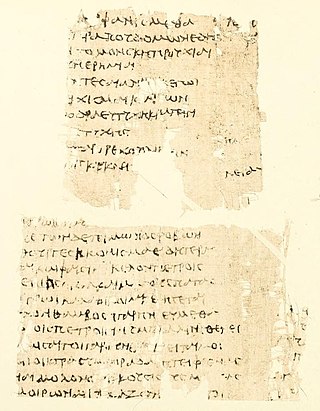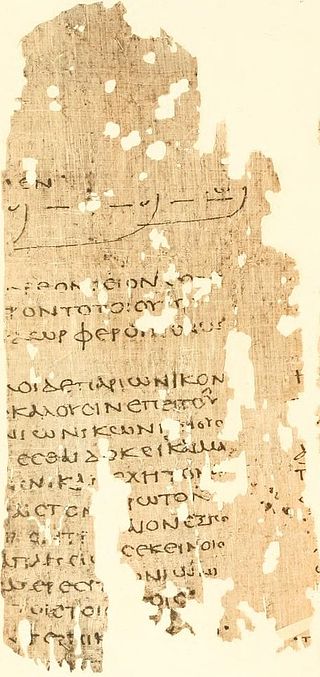Related Research Articles
Papyrus Oxyrhynchus 210 is an early Christian fragment, written in Greek. It was discovered in Oxyrhynchus. The manuscript was written on papyrus in the form of a codex. It is dated to the third century. Currently it is housed in the Cambridge University Library (4048) in Cambridge.

Papyrus Oxyrhynchus 211 is a fragment of the Perikeiromene (976–1008) of Menander, written in Greek. It was discovered in Oxyrhynchus. The manuscript was written on papyrus in the form of a roll. It is dated to the first or second century. Currently it is housed in the Houghton Library (3734) of Harvard University.
Papyrus Oxyrhynchus 212 consists of three fragments of a comedy of Aristophanes, written in Greek. It was discovered in Oxyrhynchus. The manuscript was written on papyrus in the form of a roll. It is dated to the first or second century. Currently it is housed in the British Library in London.

Papyrus Oxyrhynchus 213 consists of two fragments of a tragedy by an unknown author, written in Greek. It was discovered in Oxyrhynchus. The manuscript was written on papyrus in the form of a roll. It is dated to the second century. Currently it is housed in the British Library in London.
Papyrus Oxyrhynchus 214 is a fragment of an epic by an unknown author, written in Greek. It was discovered in Oxyrhynchus. The manuscript was written on papyrus in the form of a codex. It is dated to the third century. Currently it is housed in the British Library in London.
Papyrus Oxyrhynchus 216 is a rhetorical exercise by an unknown author, written in Greek. It was discovered in Oxyrhynchus. The manuscript was written on papyrus in the form of a roll. It is dated to the first century BC or first century AD. Currently it is housed in the Beinecke Rare Book and Manuscript Library (35) of the Yale University.
Papyrus Oxyrhynchus 217 is a letter to a king of Macedon by an unknown author, written in Greek. It was discovered in Oxyrhynchus. The manuscript was written on papyrus in the form of a roll. It is dated to the third century AD. Currently it is housed in the Cambridge University Library (35) in Cambridge.
Papyrus Oxyrhynchus 218 is a historical fragment by an unknown author, written in Greek. It was discovered in Oxyrhynchus. The manuscript was written on papyrus in the form of a roll. It is dated to the third century AD. Currently it is housed in the British Library in London.

Papyrus Oxyrhynchus 220 is a treatise on prosody, written by an unknown author in Greek. It was discovered in Oxyrhynchus. The manuscript was written on papyrus in the form of a roll. It is dated to the first century or second century AD. Currently it is housed in the British Library in London.
Papyrus Oxyrhynchus 223 is a fragment of Homer's Iliad (E,329-705), written in Greek. It was discovered in Oxyrhynchus. The manuscript was written on papyrus in the form of a roll. It is dated to the third century. Currently it is housed in the Bodleian Library in Oxford.
Papyrus Oxyrhynchus 224 is a fragment of the Phoenissae, a tragedy of Euripides, written in Greek. It was discovered in Oxyrhynchus. The manuscript was written on papyrus in the form of a roll. It is dated to the third century. Currently it is housed in the British Library in London.
Papyrus Oxyrhynchus 225 is a fragment of Thucydides (II,90-91), written in Greek. It was discovered in Oxyrhynchus. The manuscript was written on papyrus in the form of a roll. It is dated to the first century. Currently it is housed in the British Library in London.
Papyrus Oxyrhynchus 226 is a fragment of the Hellenica (VI,5) of Xenophon, written in Greek. It was discovered in Oxyrhynchus. The manuscript was written on papyrus in the form of a roll. It is dated to the first or second century. Currently it is housed at Columbia University in New York City.
Papyrus Oxyrhynchus 227 is a fragment of the Oeconomicus of Xenophon, written in Greek. It was discovered in Oxyrhynchus. The manuscript was written on papyrus in the form of a roll. It is dated to the first century. Currently it is housed in the British Library in London.
Papyrus Oxyrhynchus 249 is a fragment of a registration of some property, written by an unknown author, in Greek. It was discovered in Oxyrhynchus. The manuscript was written on papyrus in the form of a sheet. It is dated to 10 October 80. Currently it is housed in the Beinecke Rare Book and Manuscript Library of the Yale University in New Haven.
Papyrus Oxyrhynchus 257 is a fragment of a census return, in Greek. It was discovered in Oxyrhynchus. The manuscript was written on papyrus in the form of a sheet. It is dated to the year 94-95. The owner of the fragment and the place of its current housing is unknown.
Papyrus Oxyrhynchus 274 is a fragment of a Register of Property, in Greek. It was discovered in Oxyrhynchus. The manuscript was written on papyrus in the form of a sheet. It is dated to 28 August 97. Currently it is housed in the Union Theological Seminary in New York City.
Papyrus Oxyrhynchus 287 is a fragment of a Payment of Corn, in Greek. It was discovered in Oxyrhynchus. The manuscript was written on papyrus in the form of a sheet. It is dated to the 23 November 23. Currently it is housed in the library of the Columbia University in New York City.
Papyrus Oxyrhynchus 289 is a fragment containing taxation accounts, in Greek. It was discovered in Oxyrhynchus. The manuscript, written on papyrus in the form of a sheet, was written after 26 January 83. Currently it is housed in the British Library in London.
Papyrus Oxyrhynchus 290 is a fragment of a Work on Embankments, in Greek. It was discovered in Oxyrhynchus. The manuscript was written on papyrus in the form of a sheet. It was written between 83-84. Currently it is housed in the University Museum of the University of Pennsylvania in Philadelphia.
References
- ↑ P. Oxy. 215 at the Oxyrhynchus Online
- 1 2 3 Grenfell, B. P.; Hunt, A. S. (1898). Oxyrhynchus Papyri II. London: Egypt Exploration Fund. pp. 30–33.
![]() This article incorporates text from a publication now in the public domain: B. P. Grenfell; A. S. Hunt (1899). Oxyrhynchus Papyri II. London: Egypt Exploration Fund.
This article incorporates text from a publication now in the public domain: B. P. Grenfell; A. S. Hunt (1899). Oxyrhynchus Papyri II. London: Egypt Exploration Fund.